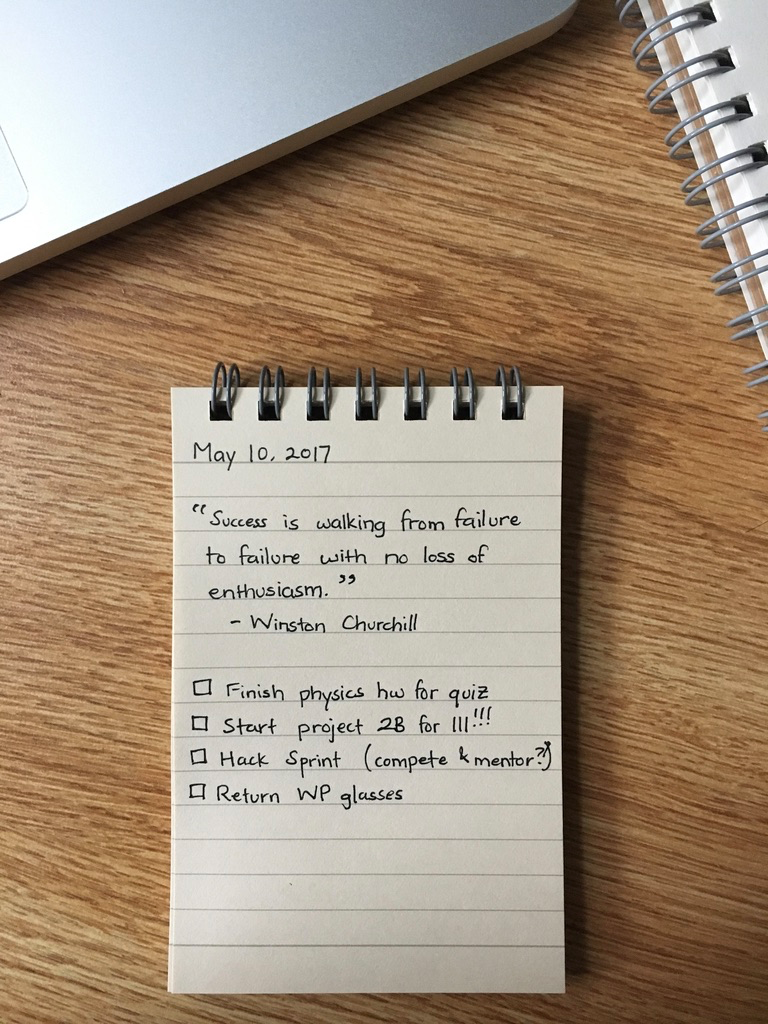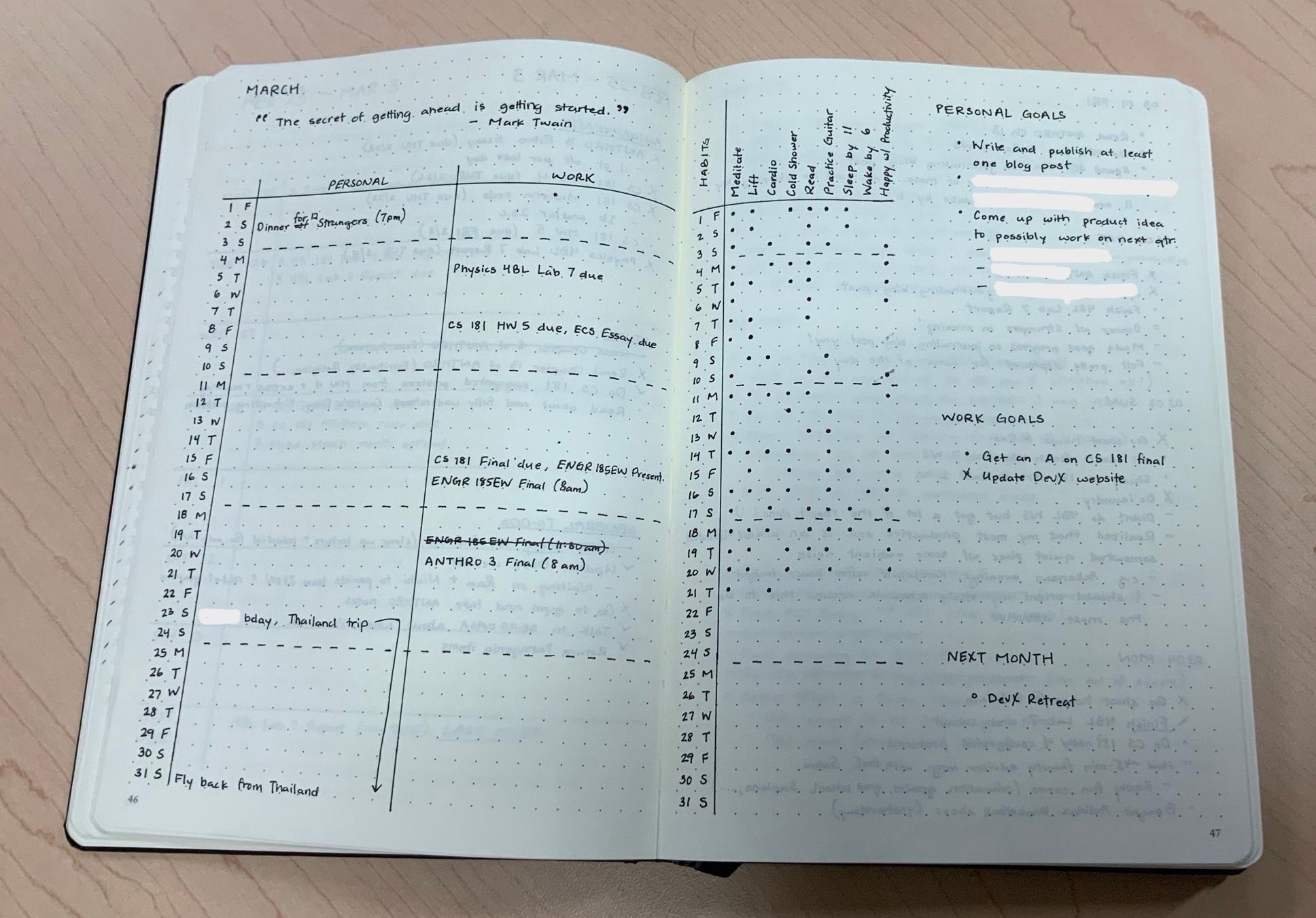In December of 2014, I made a New Year's resolution to write a journal entry every day for the next year. Although this resolution stumbled after three months of consistency, it successfully fostered in me a (hopefully) lifelong journaling habit.
In those early days, journaling simply meant jotting down my thoughts from the day onto the cream-colored pages of a notebook each night before bed. In the nearly five years since that first journal, however, I've explored a broad set of ways to journal. In this post, I want to reflect on, categorize, and share my experience with these four categorizations, or "ways of journaling".
Journaling as a way of giving inner thoughts an outlet
This is the way of journaling I started with. Straightforward yet effective, it is likely the journaling style most people associate with the word "journaling". Each night before going to sleep, I'd sit in bed and jot down whatever was bouncing around in my mind. Some nights my thoughts would fill up two or three pages. Other nights I'd struggle and yawn through writing a single paragraph.

I didn't really know what the purpose of these journal entries would be but that was okay; I did it simply because I enjoyed the routine. Reflecting on each day isn't something I would have otherwise done, so creating a structured time and place to do it each day has helped me become more introspective and intentional. When I read through those earliest journal entries today, I get a humorous yet valuable glimpse into the day-to-day worries of the 17-year-old me. It also reminds me to zoom out and look at the bigger picture.
One of the things I struggled with in this style of journaling was that the permanence of the words I wrote prevented me from writing with complete freedom and honesty. In particular, in the tumultuous months of early 2017 after my dad passed away, I found myself having thoughts that I didn't want to write because (1) I was worried others would read them and (2) even I didn't want to read them after I had written them. I just wanted a way to transfer my thoughts into words and be done with them.
Fortunately, an excellent solution revealed itself to me in the pages of a book I read around that time, Emotional Agility by Susan David. In it, David describes a style of journaling introduced by Dr. James Pennebaker.
Set a timer for twenty minutes. Open up your notebook, or create a new document on your computer. When the timer starts, begin writing about your emotional experiences from the past week, month, or year. … Simply go wherever your mind takes you, curiously and without judgement. Write just for yourself and not some eventual reader. Then, throw the paper away (or stick it in a bottle and cast it out to sea) or close the document without saving it.
So, for the next few days, I tried it out by writing into a blank document on my computer, then closing it without saving. It was perfect. I found it so therapeutic that I created a website, Unjournal, designed to make this process even easier and more fun. Shameless plug, I know. But if the idea sounds like it'd help you, I invite you to give it a try.
Journaling as a way of documenting memories in a rich and detailed way
One of my favorite things about journaling is its ability to help us record and look back on so much more than our feeble human memories can store. While pen-to-paper journaling can do this to a limited degree, the most effective way is undoubtedly to use a digital journaling app. My favorite is Day One.
Since mid-2013, I've amassed nearly 800 richly detailed entries containing pictures, locations, tags, weather information, and much more. With so much context attached to the entries, looking back through them becomes a really fun experience. Day One makes this reflection process even easier by giving you a notification each day about your entries on this day in previous years.

Much like the saying, "The best camera is the one you have on you", the best journal is also the one you have on you. Since apps like Day One are available across most platforms (iOS, Android, Mac, etc.), it's really convenient to log what's going on in your life, so you're more likely to do it.
Journaling as a way of gathering and analyzing data about one's life
Okay yeah, I'll admit. This one sounds a bit geeky and obsessive. That's because it is.
Since my early teenage years, I've been obsessed with the concept of habits. One of my favorite quotes, by Will Durant*, is "We are what we repeatedly do. Excellence, then, is not an act but a habit." It's an idea I try to live by every day. In the beginning of my obsession with habits, I extensively used apps like Coach.me and Strides Habit Tracker to keep myself accountable and to get an overarching view on how consistent I was being with my habits.
Although these apps do 90% of what I was looking for, I found myself wanting to take more control over the types of statistics and insights I wanted to glean from my habit patterns. So during the summer of 2018, I decided to make a custom Google Sheets spreadsheet and document everything there.

The emoji column headers may be a bit cryptic, so in translation, I chose to track the following habits/items:
Weight lifting, cardio, plan your day in the morning, no unnecessary expenses, practice guitar, read, write, listen to podcasts, take a cold shower, diet, phone usage (thanks to the Moment app or as of iOS 12, Screen Time), meditation duration/time, sleep time, mood, and more.
There are also a few other columns that didn't fit into the picture above:
3 adjectives describing my mood, 3 things I'm grateful for, 2-3 achievements of the day, and room for growth
It may seem like a lot of work to fill out but it really only took about 5 minutes each night and served as an excellent method for reviewing the day in a more structured and intentional way than jotting scattered thoughts in a notebook.
After a few weeks of collecting data like this, I started creating all sorts of graphs/charts in Sheets to see if I could find patterns and correlations. Here are a few of the ones I found the most interesting.




Despite the fact that correlation doesn't imply causation, the insights gained were at least useful in affirming or rejecting my own beliefs in what works well for my life.
Some ways I've considered to take this to the next level (but haven't had time to) include:
- Export the data and try to answer more complex questions using machine learning techniques.
- Randomly select values for certain habits each day in order to establish causation rather than just correlation.
Ultimately, I only did this for that one summer since it was a lot of work to set up, but it was definitely a worthwhile experiment. In short, if you're obsessive about habits like me or simply want to find out how different facets of your daily life are correlated to one another, this type of journaling is pretty great. If you just want some of the benefits of habit-tracking–without the extra-ness of making your own spreadsheet–habit-tracking apps like Coach.me are a great option.
Journaling as a way of structuring the chaos of everyday life
In the latter half of my sophomore year, I started facing an issue that is probably pretty common among college students. I had so much on my plate that I would get mentally fatigued just thinking about all I had to do. As a result, I'd get a lot less done than I knew I had the capacity for.
My first solution for this problem was a tiny little notebook in which I would write down 3-5 key to-dos for each day (along with a motivational quote). Anything I didn't write in there wasn't high-priority enough to think about that day.

I kept up this routine for a few months but found that it wasn't as effective as I'd hoped for. What I didn't realize then was that I had scratched the surface of a system I would discover later that does work quite effectively: bullet journaling. Unfortunately, I didn't start bullet journaling until nearly two years later. We'll get back to that in a bit... Until then, I leveled up to an app called Trello.
Inspired by a concept in computing called "multi-level priority queues (MLPQ)", I created a Trello "kanban" board with columns that represented time spans (and indirectly priority levels).

As far as productivity solutions go, this was one of the best I'd found yet. Sharing the accessible-almost-everywhere benefits of Day One, this MLPQ-based Trello board made it incredibly easy to keep the numerous threads of my life organized (pun intended, for the CS folks reading this). Among the features that were most helpful were:
- "labels" (the little color strips you see at the top of each "card") denoting what part of my life each card had to do with (personal, school, hobbies, writing, etc.)
- due dates that worked effectively as reminders thanks to the notifications on all my devices
- making sub-tasks within each card to micro-motivate myself through tasks
Despite all these benefits, a few key issues started to surface.
- As a Computer Science student, I was already staring at screens all day long so I became desperate to reduce my screen time however possible.
- The columns (especially the "Backlog" one in the picture) started getting too long. There were things in there I knew I wouldn't get around to for the foreseeable future but felt too attached to to delete. As a result, the Trello board (and my mind) were getting needlessly cluttered.
- I was using one app to track habits, another to track to-dos, and yet another (Calendar) to track events. I wanted to reduce the clutter and coalesce all these functionalities into a single system.
Right around the time that I was getting exasperated with Trello, I started hearing about a new journaling style called "bullet journaling". Touted as "the analog method for the digital age that will help you track the past, order the present, and design your future" and described by the method's creator as "a mindfulness practice disguised as a productivity system", it seemed like a pretty neat alternative to Trello that would reduce my screen time.
The official website for bullet journaling, bulletjournal.com, does a far better job at explaining the nuances of the system than I will below, so check that out if you're interested.
In short, however, bullet journaling is nothing but a methodology consisting of 4 core parts:
- Rapid logging — a concise yet elaborate system for logging tasks, events, and general notes
- Index — as you'd expect, a map of content to page numbers
- Timespan-based logs/spreads — yearly, monthly, and daily logs; at each timespan level, you can create a system that meets your own needs
- Custom collections — figure out what you need your bullet journal to do for you and make collections to accomplish that
I think the best way to understand the appeal of bullet journaling is to see concrete examples, so here are a few pages in mine. Oh also, one piece of terminology that's used in bullet journaling is the "spread", which simply refers to the two pages (left and right) you see whenever the notebook is laid open.



In design thinking, there exists a concept known as choice architecture. According to Wikipedia, it concerns "the design of different ways in which choices can be presented to consumers, and the impact of that presentation on consumer decision-making". The "timespan-based logs" component of bullet journaling is an excellent application of that idea into personal productivity. In essence, it provides a clearly-defined time and space in which to architect life decisions at varying resolutions.
At the end of each month, I plan the next one, thinking about my high-level goals and taking a long-term look at whether I've been spending time on the things that matter most to me.
At the start of each week, I plan out the details of the next 7 days, making sure I'm including things that reflect the goals I laid out in the monthly spread.
Finally, each night, I plan out the next day, pulling in tasks from my weekly spread in a mixture that is both doable and sufficiently productive.
The greatest aspect of bullet journaling, however, is its flexibility. At its core, it's nothing but a high-level framework for organizing your life. You can easily customize your own bullet journal to work for you. If my suggestions above seem like what you need, use them. If not, don't. If you feel like you have other more specific organizational needs, develop your own collections to serve them.
To summarize, the four ways of journaling I have discovered and found useful are:
- journaling as a way of giving your inner thoughts an outlet
- journaling as a way of documenting memories in a rich and detailed way
- journaling as a way of gathering and analyzing data about one's life
- journaling as a way of structuring the chaos of everyday life
Ultimately, this is a loose and non-mutually-exclusive categorization of ways of journaling. There is overlap between some ways and clear strengths for others. My current journaling habit consists of bullet journaling with occasional special appearances from the other types, but I do want to incorporate the outlet-for-thoughts and memory-documenting styles more moving forward.
Do you journal? If so, what has your experience been like? Let me know on Twitter (@bibekgg) or in the comments below.
* Interestingly, this Will Durant quote is very often misattributed to Aristotle.

